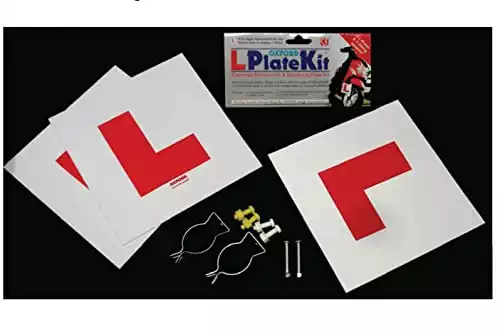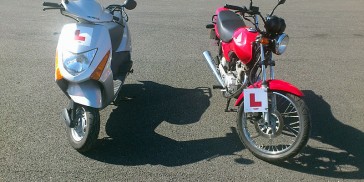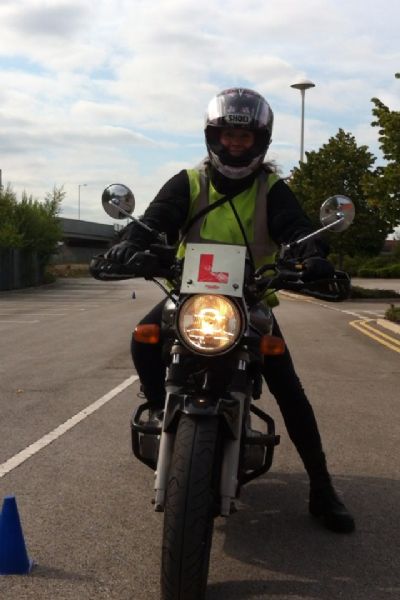Here are some important things you need to know before you go out and throw some L plates on your bike, as it isn’t quite as simple as it seems.
In this article, I get into the ins and outs of the motorcycle L plate law.
I am here to ensure you are following the letter of the law so you can avoid any unsavoury police encounters, keep yourself safe and most importantly, focus solely on riding, which is, after all, the fun bit.
Save Money On Your Motorcycle Insurance
- You could pay less than £195*
- Compare quotes from 25+ UK providers
- Fill in one form to compare top bike insurers
Pre L plates
Before you go ahead and fit your L plates and set out for a ride, you should first check that you meet the necessary criteria to be legally allowed to ride alone on the road.
- Do you have a provisional license as a minimum or a full UK driving license?
- Have you completed a CBT course and received your certificate?
If the answer is yes to both of those things, then you are legally allowed to ride a motorcycle up to 125cc with a power output not exceeding 11 kW on a public road.
Read our guide to the best learner motorcycles.
You must display L plates, and you are only entitled to ride in these circumstances for 2 years unless you then undertake a CBT renewal course or go on to obtain your full motorcycle license.
If you are 16 or over, have a provisional moped license and have completed a CBT course, you can then go on to ride a moped that doesn’t exceed 50cc. This is with the same stipulations, such as displaying L plates.
Okay, so you are good to go; you have your license, CBT certificate, bike, insurance and tax. The last step is L plates, so what does the law say?
What the Law says about L plates
Any vehicle driven by a learner must display red L plates. You can use either red D plates, red L plates, or both in Wales.
Where do you have to display L plates?
You must display L plates at both the front and back of your motorcycle.
They must be upright and as close to a 90° angle as possible.
They should be clearly visible to others from the front of the vehicle and behind it.
The most common place to mount an L plate on the front of your motorcycle is in between your front forks or attached using a mount and clips to one side of your forks.
The most accessible place to mount your L plate on the rear is just under your number plate.
Usually, you will find two holes at the bottom of the number plate, which you can then adhere to your L plate too using fixings that they come with.
If there are no holes here, it is easy to drill through; be sure to do this at the bottom of the number plate so you don’t obstruct the number plate itself.
Sometimes it is possible to fit your L plate to your windshield or the front fairing. Make sure your plate is clearly visible, not obstructed by anything, and upright as much as possible.
On a moped/scooter, the front bodywork varies, but if you have a reasonably flat place, you may be able to use a base mount to stick a front L plate on directly; else, use a clip and bracket the side of your front forks.
L Plate Requirements
The UK Government has precise requirements that L plates have to meet to be legal.
The plate has to have a white background with the red letter ‘L’. (It be a letter ‘D’ in Wales)
Also, the size of the actual plate and the red letter ‘L’ are dictated under these requirements.
Types of L plates
There are several types of L plates that come with different fittings.
Your best bet is to go for a set with a rigid front and rear plate, with mounting brackets for your front forks and fittings to attach to your number plate on the rear.
Please note that some L plate sets sold in stores are not suitable for motorcycles and are strictly for car use as they will have magnets stuck to the back of the plates.
It is also advised not to go for L plates that come in the form of stickers to wrap around your forks or rear mudguard.
Mounting them in this manner is not considered to be ‘clearly visible’.
 Oxford L plate Kit
Oxford L plate Kit
Cheap as chips, basic L plate kit that will do the job for most scooters and motorbikes.
Keep them clean and secure
It might sound simple, but you would be surprised how many people ride around with dirty L plates.
If the L plate is dirty, it is not clearly visible and therefore is not fit for purpose. It is good practice to wipe them over to ensure they can be seen on the road.
Always check your L plates are fitted securely and not cracked.
They are just a bit of plastic; wind and road debris can crack them easily, and they can break and fall off while riding.
Replacing your L plates when you notice they are cracked will reduce your risk of losing a plate mid-ride.
It is a bit of a pain but worth keeping on top of.
The front plate attached to your fork can sometimes be turned around by the wind, and you will have to keep turning it to face forward again.
I ended up using a couple of cable ties on top of the clips that came with my plates on the front, and these kept my front plate secured to my fork nice and tight.
FAQ
Can you cut L plates down to make them smaller?
It is illegal to cut down your L plates to make them smaller than the dimensions the Government requires.
You are allowed to round off the corners of the plates, but they must remain 178mm x 178mm.
If you are pulled over by the police and have cut down your L plates, you can be fined for doing so.
Why do you have to display L plates?
L plates identify you as a learner rider on the road to other road users.
As a learner, you will have limited road riding experience, and if other drivers/riders can identify this quickly, the idea is that they will allow you more space and time in case you make a mistake.
Displaying L plates is intended to keep you safer out on the road.
I had my driving license before 1st February 2001. Do I need to display L plates?
If you passed your car driving license test before the 1st February 2001, then you can legally ride a 50cc moped without displaying L plates.
Although you are recommended to undertake a CBT course, this is not mandatory.
If you obtained your full driving license after this date, you must display L plates and complete a CBT course before you can ride a moped on the road.
If you wish to ride anything bigger than a 50cc moped, you must attend a CBT course and gain your certificate before you can ride (up to 125cc) on the road with L plates.
What happens if my L plates aren’t up to standard and I get pulled over by the police?
Interactions with the police vary from incident to incident and will depend on the individual situation you find yourself in.
Not displaying L plates or displaying them incorrectly can result in points on your license and/or a fine.



